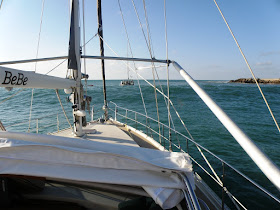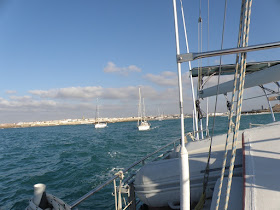There could be worse places to be stuck for an extra week. We did not mind the delay because there was still plenty of time for us to get to Lanzarote in the Canary Islands before the rally seminars started on 9 Nov.
One day we joined Virginia and Dennis of S/V Libertad for a day in the actual city of Rabat. We were all getting a little stir-crazy staying in the marina and needed an outing. Virginia suggested the contemporary arts museum and lunch in the city and that sounded like an excellent idea.
 |
| Literally walked the soles off my shoes -- again. |
 |
| Moroccan Andy Warhol? |
 |
| Every item in this photo is made from a bullet or shell casing. Art from ammunition |
The Mohammed VI Modern and Contemporary Art Museum was better than I had anticipated. This is the first contemporary art museum in Morocco and fitting that it should be built in the nation's capital. A pet project of the king. This is a nice modern building, very different from the typical local architecture.
 |
| This museum has some very unusual works of art. Here is a bathtub made from the inner layer of lamb hides. |
 |
| Pastillo for lunch |
While eating lunch a protest started in the nearby main street. Being in a country where we do not speak the language and having several thousand people marching in the street and yelling is a bit disconcerting. I asked the cafe owner what they were protesting. She explained that the university for medical study is located only a couple of blocks down the street and that these were students protesting the mandatory medical service they will be required to serve once they graduate. The protest seemed to go on and on and on for a long time. Finally it broke up and we headed back to the light-rail tram to return to the marina. Many of the young people on the tram carried rolled-up medical coats and lab coats, obviously having participated in the protest march.
 |
| One of the entrances of old walled city of Sale |
 |
| A small section of a corner of walled city of Sale |
 |
| The wall of old Sale went on for miles. the tents are merchant stalls outside the old city. |
Sale has always been known for stirring things up.
This was where the first protests were held in the early 1950s that led to the national movement insisting upon independence from the French. In the 1600s the town was infamous for its pirates known as the Salee Rovers. This town was so famous for pirate activities that Daniel Defoe wrote the city into his novel 'Robinson Crusoe,' placing Robinson in the captivity of the Salee Rovers.
 |
| The very short finger piers at the marina have no cleats. Lines are run around and through this large metal protrusion at end of each finger pier. Works fine. |
On Friday afternoon, 30 October 2015, at 15:45 we finally exited the Rio Bouregreg into the Atlantic. There were 6 boats leaving the marina at the same time; we looked like a convoy. Two boats were going down to Agadir, Morocco; and 4 of us were headed to Lanzarote, Canary Islands. Our exit was at precisely slack high tide on a 3.6 meter tide, so depth going out was not problem whatsoever. And the incoming swell was almost imperceptible because of that 3.6 meter tide. Perfect timing as we all followed the marina guide boat out into the Atlantic.
 |
| Looking forward as we passed the Customs dock headed outbound. Old walled city of Rabat ahead. |
The swell was there but was no problem because of the slack high tide. If we looked closely at the boat in front of us we could see the effects of the swell. But we did not feel it at all.
 |
| At same time, looking backwards at the other 4 boats in convoy behind us. |
Passing the old walled city of Rabat was a bit sad as we said a final goodbye to not just Rabat but also to Morocco; and also to the continent of Africa. Have no plans of ever returning to any place in Africa. Glad Morocco was our introduction and farewell to the continent.
 |
| Old walled city of Rabat on our left as we closely followed S/V Pimentau, as they closely followed the guide boat. |
 |
| Swell was barely perceptible as we exited. But look more closely. S/V Pimentau was up. |
 |
| And then S/V Pimentau was down. |
 |
| While looking behind us, these 2 boats first were up. |
 |
| And then the left one was very much down, while S/V Libertad on the right was still up. So...yeah...there was some swell. |
 |
| Goodbye Rabat! Goodbye Africa! |
 |
| The beginning of a rainbow welcoming us to Lanzarote. The island is visible on left side. A very welcome sight after the seasick conditions for 2 days. |
By 04:00 Monday morning the seas has subsided by half, down to barely over 2 meter waves and wind about 15 kts. Our course allowed us to turn more southerly at this time and the remaining 10 hours into Lanzarote was much, much more comfortable. Thank you, Lord, for small favors! We each found something to eat and began sipping fluids.
When we docked at Marina Lanzarote, several men came to help with our dock lines. We were so tired that neither of us recognized these men. After the lines were secure we looked around and saw 2 Amel boats docked nearby and then realized who the men were! More about that in a future posting.


No comments:
Post a Comment
Your comment will be posted after we confirm that you are not a cyber stalker.